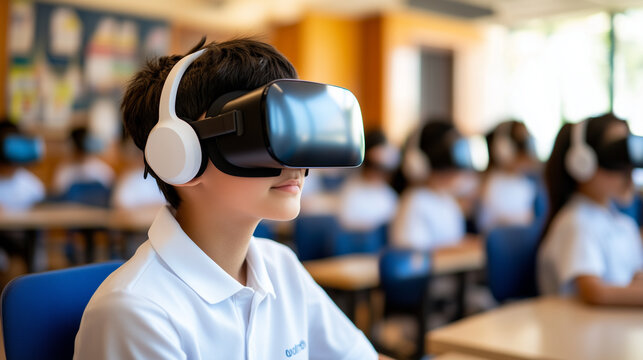Traditional classroom learning is evolving rapidly, with Artificial Intelligence (AI) and Virtual Reality (VR) revolutionizing how students interact with educational content. AI-driven VR enhances engagement, personalizes learning experiences, and bridges the gap between theory and practice by immersing students in interactive environments. This technology is reshaping education across various disciplines, from medical training to STEM education and skill development.
How AI and VR Work Together in Education
1. AI-Driven Personalization in Virtual Learning
- AI customizes VR lessons based on a student’s learning pace, strengths, and weaknesses.
- Adaptive algorithms adjust difficulty levels to ensure optimized learning outcomes.
- AI-powered chatbots and virtual assistants provide real-time guidance and feedback.
2. Immersive and Experiential Learning through VR
- VR simulations allow students to explore historical events, conduct science experiments, or practice skills in a risk-free environment.
- AI enhances these simulations by making them dynamic and responsive to student interactions.
- Example: Medical students can perform virtual surgeries with real-time AI feedback, improving their skills before working on real patients.
3. Real-Time Assessment and Performance Analytics
- AI tracks student eye movements, engagement levels, and response times to assess comprehension.
- Automated feedback provides personalized recommendations for improvement.
- AI-driven analytics help educators understand learning patterns and challenges, enabling better curriculum adjustments.
Applications of AI-Powered VR in Different Educational Fields
1. STEM Education and Laboratory Simulations
- Virtual physics and chemistry labs allow students to conduct experiments without physical risks.
- AI guides students through complex engineering models in real-time, helping them visualize structures before building them.
- Example: NASA uses AI-powered VR to train astronauts in simulated space environments.
2. Medical and Healthcare Training
- AI-driven VR helps medical students practice surgeries, diagnose diseases, and understand human anatomy through hyper-realistic simulations.
- Virtual patients powered by AI provide realistic symptoms and responses for improved medical training.
- Example: Johns Hopkins University incorporates VR for surgical training, improving precision and decision-making skills.
3. History and Cultural Immersion
- Students can “time travel” to historical events, witnessing ancient civilizations, wars, and cultural transformations firsthand.
- AI personalizes the experience, adjusting narratives based on student curiosity and exploration patterns.
- Example: The British Museum offers AI-powered VR tours that provide deeper insights into historical artifacts.
4. Language Learning and Communication Skills
- AI-powered VR creates real-world language immersion by simulating conversations with native speakers.
- Real-time pronunciation and grammar correction enhance fluency and confidence.
- Example: Apps like Mondly VR allow users to practice multiple languages in AI-driven virtual environments.
5. Workforce Training and Skill Development
- AI-enhanced VR training programs prepare professionals for industries such as aviation, manufacturing, and healthcare.
- Simulated emergency response drills improve decision-making and crisis management skills.
- Example: Walmart and Boeing use VR simulations for employee training, reducing training costs and improving retention rates.
Benefits of AI-Powered VR in Education
1. Increased Student Engagement and Retention
- Interactive VR experiences capture student attention better than traditional textbooks and lectures.
- AI-driven adaptive content keeps students motivated and actively involved in the learning process.
2. Accessibility and Inclusion in Education
- AI and VR make learning more accessible for students with disabilities or learning differences.
- VR classrooms enable students in remote areas to access high-quality education without physical limitations.
3. Safe and Cost-Effective Learning Environments
- Virtual training minimizes risks associated with hazardous experiments and real-world practice.
- AI-driven simulations reduce the cost of physical lab equipment, travel, and training resources.
Challenges and Considerations in AI-Powered VR Education
1. High Implementation Costs
- VR headsets, AI software, and high-performance computers require significant initial investment.
- Schools with limited funding may struggle to adopt AI-powered VR solutions.
2. Technical Barriers and Learning Curve
- Educators and students need training to effectively use AI-VR tools in classrooms.
- Internet connectivity and hardware limitations can impact seamless VR experiences.
3. Ethical and Data Privacy Concerns
- AI-driven VR collects large amounts of student performance data, raising concerns about privacy and data security.
- Transparent policies are needed to safeguard user data and ensure ethical AI practices.
- AI-powered VR classrooms will become more affordable and accessible with technological advancements.
- Integration with 5G and cloud computing will enhance real-time remote learning experiences.
- AI-driven emotion recognition technology will help customize learning environments based on student moods and engagement levels.
As AI and VR continue to evolve, their impact on education will reshape traditional learning models, making education more immersive, engaging, and personalized.

